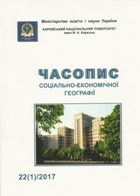Optimization of shool education institutions network in Ukraine in conditions of administrative-territorial reform: reasons, regional differences, ways of implementation
Abstract
The authors of the article analyse the dynamics of the network of general educational institutions in the post-Soviet period ofUkraine's development. They determine that the rate of reduction of the schoolchildren contingent (47.5%) during 1990-2016 significantly exceeded the rate of reduction in the number of educational institutions (22.5%), which caused the formation of ungraded schools. It is stated that the largest number of ungraded schools belongs to the regions with a complicated demographic situation and low populated settlements, in particular Chernihiv andSumyregions. The general financial resources allocated by the state for the support of educational institutions of the united territorial communities in the form of educational subventions are calculated. It has been proved that the costs of education take a leading place in the overall expenditure structure of local communities but their share (30-40%) is almost the same as in many European countries. The main reasons for the regional differences in spending on education in territorial communities are the fullness of classes, the contingent of schoolchildren and the energy efficiency of educational institutions. The article shows that the main mechanisms for stimulating the reform of schools and improving the quality of educational services are the fixed amount of educational subventions for the maintenance of one student (9.3 thousand UAH) established by the state, clearly defined criteria for the formation of hub schools and their branches. Taking into account the international experience, the article proves the expediency and determines the ways of optimizing the school institutions network inUkraine.
The results of the research define that: a) further development of the territorial reform will definitely aggravate the problem of the functioning of general educational institutions; b) the closure of school institutions cannot be regarded as the main result of education reforms; c) optimization of the school institutions network in territorial communities is an important and necessary step in building an effective system of providing quality educational services.
Downloads
References
2. Kutsenko, V.I. (2007). Rozvytok sotsialnoi sfery v umovakh formuvannya rynkovykh vidnosyn (pytannia teorii i praktyky) [Social sphere development in the emerging market economy (questions of theory and practice). K.: RVPS Ukrainy NAN Ukrainy,100.
3. Mistseve samovryaduvannya u krainakh Skandynavii ta Baltii. Ohlyad / avtorskyi kolektyv D. Yang ta inshi (2016) [Local governments in Scandinavian and Baltic countries. Review]. SKL International, 59.
4. Niemets, K.A. (2014). Systema osvity Kharkivskoi oblasti: suspilno-geohrafichnyi aspekt: monografiya [The educa-tion system of Kharkiv region: the socio-geographical aspect: monograph]. Kharkiv: FOP Petrov V.V., 180.
5. Niemets, L.M. (2003). Prostorova organizatsiya sotsialno-geografichnykh protsesiv v Ukraini: monografiya [The spatial organization of social and geographical processes in Ukraine: monograph]. Kharkiv: RVV KhNU, 160.
6. Niemets, L.M. (2008). Suchasna terytorialna organizatsiya zakladiv doshkilnoi osvity u Sumskiy oblasti [The cur-rent territorial organization of pre-school educational institutions in Sumy region]. Chasopys sotsialno-ekonomichnoi geografii. Kharkiv: KhNU imeni V.N. Karazina, 4 (1), 156-161.
7. Tkachuk, A. (2015). Skandynavskyi shlyakh. Dosvid reform administratyvno-terytorialnoho ustroyu i mistsevoho samovryaduvannya u Danii ta Shvetsii [Scandinavian way. Experience of the reform of administrative and territo-rial structure and local governments in Denmark and Sweden]. Kopenhahen-Stokholm-Kyiv, 48.
8. Shevchuk, A.V. (2014). Regionalni osvitni systemy: teoriya, metodologiya, praktyka: monografiya [Regional educa-tional systems: theory, methodology, practice: monograph]. Lviv: IRD NAN Ukrainy, 420.
9. Shyian, R. (2016). Detsentralizatsiya osvity u Polshchi: dosvid dlya Ukrainy [Decentralization of education in Po-land: experience for Ukraine]. K., 44.
Copyright (c) 2017 Микола Барановський, Ольга Барановська

This work is licensed under a Creative Commons Attribution 4.0 International License.




